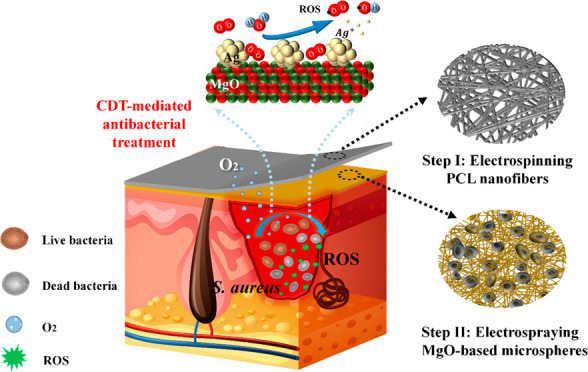- Record: found
- Abstract: found
- Article: found
Nanofibrous Dressing with Nanocomposite Monoporous Microspheres for Chemodynamic Antibacterial Therapy and Wound Healing

Read this article at
Abstract

The excessive use of antibiotics and consequent bacterial resistance have emerged as crucial public safety challenges for humanity. As a promising antibacterial treatment, using reactive oxygen species (ROS) can effectively address this problem and has the advantages of being highly efficient and having low toxicity. Herein, electrospinning and electrospraying were employed to fabricate magnesium oxide (MgO)-based nanoparticle composited polycaprolactone (PCL) nanofibrous dressings for the chemodynamic treatment of bacteria-infected wounds. By utilizing electrospraying, erythrocyte-like monoporous PCL microspheres incorporating silver (Ag)- and copper (Cu)-doped MgO nanoparticles were generated, and the unique microsphere-filament structure enabled efficient anchoring on nanofibers. The composite dressings produced high levels of ROS, as confirmed by the 2,7-dichloriflurescin fluorescent probe. The sustained generation of ROS resulted in efficient glutathione oxidation and a remarkable bacterial killing rate of approximately 99% against Staphylococcus aureus ( S. aureus). These dressings were found to be effective at treating externally infected wounds. The unique properties of these composite nanofibrous dressings suggest great potential for their use in the medical treatment of bacteria-infected injuries.
Related collections
Most cited references59
- Record: found
- Abstract: found
- Article: not found
Antimicrobial strategies centered around reactive oxygen species--bactericidal antibiotics, photodynamic therapy, and beyond.
- Record: found
- Abstract: not found
- Article: not found
Nanocatalytic Theranostics with Glutathione Depletion and Enhanced Reactive Oxygen Species Generation for Efficient Cancer Therapy
- Record: found
- Abstract: not found
- Article: not found